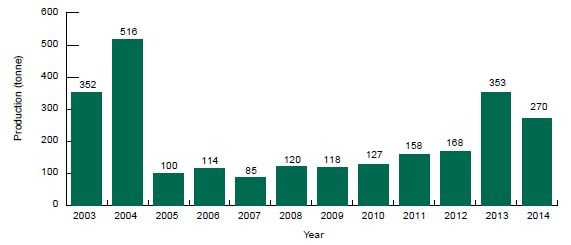1 General overview
The aquaculture development in Oman started in 1992 with the research activities as trials for different local species. Ministry of Agriculture & Fisheries aims from these researches to test local species under local conditions. These researches include local Indian white shrimp (Penaeus indicus) culture (Gindy et al., 2000a,b), cage culture of European sea bream, Saprus aurata (Al-Qasmi et al., 1998), local abalone culture (Haliotis mariae), hatchery techniques for local silvery black sea bream (Acanthopagrus cuveiri), biology and hatchery techniques for local sea cucumber (MAF, 2011).
For aquaculture site selection, two surveys were conducted (Gindy, 1999 and Al-Yahyai, et al., 2004). The aim of these two surveys was to define and select the suitable sites for aquaculture. The second survey, which was conducted in 2004, was more comprehensive and includes the whole coast of Oman.
After the success of these researches and their proven applicability of different aquaculture projects in Oman
Figure 1. Total aquaculture production in Oman, 2003–2014.
with local species, the private sector started to invest in aquaculture with marine cage culture of European sea bream; the first project started in 2002. This project was in the Bandar Khyran area in Musact Governorate.
The first commercial production in Oman was in 2003 which reached 253 tonne. This production was from the marine cage project. The majority of this production was European sea bream. Figure 1 shows the aquaculture production since 2003 until 2013. The highest production was in 2004 which was 516. From 2007, all the production consists of shrimp produced from shrimp farms in the Mahout region in the middle of Oman. Freshwater integrated aquaculture in Oman is very limited currently, but it represents good opportunities for development. In 2013, the production of tilapia was 3 tonne only which increased to reach 20 tonne by the year 2015.
The Ministry of Agriculture & Fisheries realizes the importance of sustainable development of aquaculture and to put a clear plan to achieve this sustainability.
Therefore, and in coordination with FAO, it prepared the master plan for aquaculture development in 2007 which was considered as the main turning point in the aquaculture development process in Oman. Based on this plan, the Ministry of Agriculture & Fisheries takes several initiatives which include but is not limited to the following:
1. Atlas for suitable sites for aquaculture;
2. Establishment of aquaculture committee;
3. Establishment of aquaculture centre for researches and directorate of aquaculture development for investment opportunities and monitoring;
4. Issuing aquaculture by-laws; and
5. Preparation of investment guidelines.
In 2011, the Ministry of Agriculture & Fisheries (MAF) developed the strategy for aquaculture development 2011–2030. This strategy was based on several studies conducted by the MAF in cooperation with FAO, such as an aquaculture master plan conducted in 2007 (FAO, 2007), food safety and environment in aquaculture (FAO, 2008) and consultation with different experts. The main objectives of this strategy include:
1. Developing aquaculture in a sustainable manner using modern technology such as GIS and ecosystem based management;
2. Developing the local communities and increasing their participation in the projects;
3. Encouraging the small and medium enterprise;
4. Increasing the fisheries production through the increase of aquaculture production. Annual growth 20 percent;
5. Attracting and encouraging the foreign investment through incentives.
Through the implementation of this strategy, the Ministry of Agriculture & Fisheries expects to achieve the following:
1. Increase the aquaculture production to reach 20,000 by year 2040;
2. Increase the contribution of aquaculture to GDP and diversification of the economy;
3. Provide job opportunities for Omanis;
4. Enhance the supporting sector such as feed mills, processing, etc.; and
5. Preparation of BAP booklets.